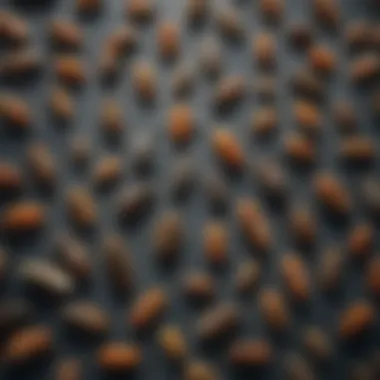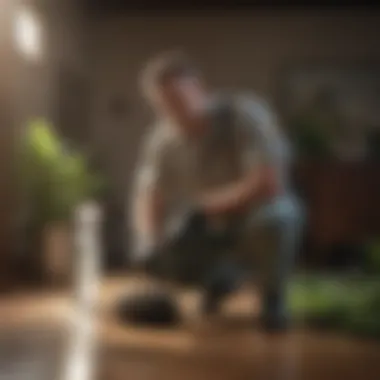Effective Pest Control Solutions in Baltimore


Intro
Pest control plays a crucial role in maintaining the health and safety of our homes. In Baltimore, a city rich in history and diversity, the challenges posed by pests are both numerous and unique. American Pest Control provides services tailored to address these specific issues. Understanding the local pest population and implementing effective control measures are vital for homeowners looking to protect their properties. This article will guide readers through the types of pests commonly found in Baltimore, prevention techniques, and eco-friendly pest control solutions.
Understanding Pests
Definition of Pests
Pests are organisms that can cause harm to humans, animals, or the environment. They include insects, rodents, and other creatures that compete for food, multiply rapidly, and often invade living spaces. In Baltimore, the pest landscape is shaped by both urban density and environmental factors.
Importance of Pest Identification
Correctly identifying pests is essential for effective management. Different types of pests require unique treatment approaches. Knowing what you are dealing with enables you to choose the right strategy. For example, cockroaches, termites, and rodents require different control methods. Identifying a pest accurately can prevent unnecessary spending on ineffective treatments.
"Knowing your enemy is half the battle."
Prevention Techniques
Preventing pests from entering your home is more efficient than dealing with an infestation. Here are some techniques homeowners can adopt.
Home and Garden Preventative Measures
- Sealing Entry Points: Inspect your home for cracks and gaps. Use caulk or foam to seal these entry points, particularly around windows and doors.
- Keeping Clean: Regular cleaning reduces food sources for pests. Store food in airtight containers, and promptly clean up spills and crumbs.
- Managing Waste: Use sealed garbage containers and ensure regular disposal to minimize odors and pest attraction.
- Landscape Care: Trim vegetation away from the house. Overhanging branches can provide easy access for rodents and insects.
Seasonal Prevention Tips
- Spring: Inspect your home for water damage, which attracts wood-destroying pests.
- Summer: Monitor outdoor areas for ant colonies, especially near food sources.
- Fall: Check for signs of rodents seeking warmth inside as temperatures drop.
- Winter: Ensure that your home is properly insulated, as cold can lead pests to seek warmth indoors.
Eco-Friendly Pest Control Solutions
Sustainable pest management minimizes environmental impact. It emphasizes prevention and reduces reliance on harmful chemicals.
Overview of Sustainable Practices
Integrated Pest Management (IPM) combines different management strategies. This holistic approach focuses on long-term prevention and control rather than immediate fixes. It uses methods such as biological control, habitat manipulation, and cultural practices to mitigate pest problems while protecting the environment.
Natural Remedies and Their Effectiveness
- Diatomaceous Earth: A natural powder that is effective in managing insects by dehydrating them upon contact.
- Essential Oils: Oils such as peppermint and tea tree have proven repellent properties against various pests.
- Soap Sprays: Simple soapy water can deter soft-bodied pests like aphids and spider mites.
Understanding Pest Control in Urban Settings
Pest control in urban areas, such as Baltimore, presents unique challenges and requires a tailored approach. Urban environments are often characterized by higher population density and a range of residential structures. This creates the perfect breeding ground for various pests, making effective pest management crucial. Homeowners must be aware of potential risks to their properties. Understanding pest control methods can lead to better home maintenance and improved living conditions.
Effective pest control not only protects structures but also promotes public health. Pests like rodents and certain insects can transmit diseases, affecting families and communities. Therefore, knowledge of pest behavior and habitats is vital in preventing infestations. Moreover, recognizing seasonal patterns aids in the timely implementation of control measures.
Adopting integrated pest management (IPM) strategies is beneficial in urban settings. These methods are sustainable and environmentally friendly. They reduce reliance on chemical treatments, promoting healthier living spaces. Educating residents about basic pest control practices contributes significantly to urban pest management, ensuring communities work collectively.
The Concept of Integrated Pest Management
Integrated Pest Management (IPM) emphasizes the use of a variety of interconnected strategies to manage pest populations. Rather than focusing solely on pesticides, IPM incorporates biological, cultural, and physical control methods. This holistic approach minimizes health risks and environmental impacts while effectively controlling pests.
One key aspect of IPM is understanding the pest life cycle and behaviors. Knowing when and where pests are likely to invade can inform preventive measures. This might include simple changes like sealing cracks in buildings or maintaining yard cleanliness. Additionally, encouraging natural predators in gardens can provide a biological control option for managing certain pest species.
IPM focuses on long-term prevention of pest problems through a combination of techniques.
Educating homeowners about IPM principles enhances their ability to manage pest issues before they escalate. Tailored strategies for specific pests strengthen the community's overall resilience against infestations, ultimately leading to healthier living environments.
The Role of American Pest Control in Baltimore
American Pest Control plays a vital role in managing pest populations in Baltimore. Their extensive knowledge and experience allow them to implement effective solutions tailored to the urban landscape. They conduct thorough inspections to identify pest activity and recommend strategies that align with the principles of Integrated Pest Management.


With a focus on customer satisfaction, American Pest Control also educates homeowners on preventive measures they can employ. This proactive approach empowers residents to take charge of their environments. Assistance from professional services like American Pest Control is essential for addressing existing infestations efficiently while preventing future issues.
Furthermore, their commitment to eco-friendly solutions resonates with Baltimore’s increasing push towards sustainability. By integrating environmentally conscious strategies, they work to reduce the adverse effects of pest control on the ecosystem.
By actively engaging in community outreach, American Pest Control reinforces its role not just as a service provider but as a partner in contributing to safer neighborhoods. The collaboration between the company and Baltimore residents is key to sustaining effective pest management efforts.
Common Pests in Baltimore
Understanding the common pests in Baltimore is essential for homeowners looking to protect their property. Each type of pest presents unique challenges and can lead to various issues, ranging from structural damage to health risks. By familiarizing oneself with these pests, homeowners can take proactive measures to mitigate infestations and maintain a safe living space.
Identification of Household Pests
Household pests vary in type and behavior. Recognizing them is the first step toward effective management. Common household pests in Baltimore include:
- Cockroaches: Known for their resilience, cockroaches can often be spotted in kitchens and bathrooms. They thrive in warm and humid environments, making any neglected areas appealing.
- Ants: Various ant species can invade homes in search of food. Carpenter ants, in particular, are notorious for causing wood damage as they nest in structural timber.
- Mice: Rodent infestations are common in urban settings. Mice can reproduce rapidly, making early detection critical to prevent more significant issues.
- Termites: These wood-eating insects can silently cause extensive damage before detection. Homeowners should look out for mud tubes or discarded wings as signs of infestation.
Learning to identify these pests through visible signs and behaviors aids in timely interventions. It is recommended to have a professional inspection for thorough identification and assessment.
Seasonal Pest Problems
Seasonal changes significantly influence pest behavior and population dynamics. Baltimore experiences four distinct seasons, each with its typical pest challenges.
- Spring: As temperatures rise, pests such as ants and termites become more active. During this time, they seek food and nesting sites. Homeowners should monitor for trails and signs of invasion.
- Summer: The warm weather attracts various insects. Flies and mosquitoes increase in numbers, and this is also the season when rodent activity peaks as they search for food and shelter.
- Fall: As temperatures begin to drop, pests like mice and rats look for warmth inside homes. Sealing entry points is crucial in this season to prevent their entry.
- Winter: While fewer pests are active, some, like cockroaches, can survive indoors. It remains vital to maintain cleanliness and check for signs of winter pest activity, as they can become a problem as soon as heating systems are turned on.
Understanding these seasonal patterns can guide effective pest management strategies. Homeowners can plan their precautions accordingly to ensure a pest-free environment all year round.
Pest Control Services Offered
Pest control services are crucial in maintaining a safe and healthy living environment. They help manage pest populations that can damage property and threaten health. American Pest Control in Baltimore offers tailored services to meet the specific needs of homeowners. Understanding these services helps homeowners make informed decisions about pest management.
Inspection and Assessment
An initial inspection is the first step in effective pest control. During this process, professionals identify the type of pests present and assess the extent of the infestation. This step is vital as it determines the subsequent actions to take. Understanding the pest's habits and habitats also aids in crafting a targeted treatment plan. A thorough assessment can reveal hidden issues that homeowners might not notice.
Exclusion and Prevention Techniques
Exclusion techniques focus on preventing pests from entering the home. This can involve sealing cracks and crevices, securing doors and windows, and ensuring proper drainage. Prevention is more cost-effective than dealing with an infestation later. Homeowners should consider regular inspections to maintain these protective barriers. Simple actions like proper sanitation and landscape management can also deter pests from making a home in your property.
Treatment Options Available
When it comes to treatment, homeowners have a variety of options based on the specific pest and severity of the situation.
Chemical Treatments
Chemical treatments involve using pesticides to manage pests. These substances can be effective for a wide range of infestations. A key characteristic of chemical treatments is their fast action. This aspect makes it a popular choice for situations requiring immediate results. However, there are concerns regarding potential risks to health and the environment. Homeowners should balance efficacy with potential side effects.
Biological Control Methods
Biological control methods engage natural predators to manage pest populations. This approach reduces reliance on chemicals and minimizes environmental impact. The key characteristic is sustainability. By utilizing organisms that naturally prey on pests, homeowners can foster a healthier ecosystem. However, biological control can take longer to show results compared to chemical methods. Planning and patience are essential when choosing this option.
Eco-Friendly Alternatives
Eco-friendly alternatives are gaining traction among homeowners seeking safer pest management solutions. Common eco-friendly options include traps, baits, or natural repellents made from plant extracts. The key advantage is safety for humans and pets. These alternatives maintain pest control effectiveness while minimizing ecological harm. Nevertheless, it is important to note that eco-friendly solutions may require more frequent applications depending on the pest type and severity.
Engaging with pest control services like those from American Pest Control allows Baltimore residents to address their pest issues effectively while considering environmental safety.
Understanding pest control services helps prevent infestations and protects health.
Specific Pest Management Strategies
Pest management strategies are essential for addressing the specific challenges posed by pests in Baltimore. As the urban environment evolves, so do the pest populations that inhabit it. Tailored pest management techniques can ensure a more effective approach, which directly benefits homeowners and community members. These strategies not only address existing infestations but also put preventive measures in place to mitigate future pest problems. Understanding these methods is crucial for making informed decisions regarding pest control.
Rodent Control Measures


In Baltimore, rodent control measures are a fundamental aspect of pest management. Rodents, such as rats and mice, thrive in urban settings due to plentiful food sources and shelter. Implementing effective rodent control involves a combination of traps, baiting, and sanitation practices.
- Trapping: Snap traps are a traditional method that allows for quick and humane capture. Understanding where to place these traps enhances their effectiveness.
- Bait Stations: These are often used in more severe infestations. They contain poison that should be strategically placed, reducing the chances of pet or child exposure.
- Sanitation: Keeping a clean environment is crucial. Removing food sources and blocking entry points is fundamental in effectively managing rodent populations.
Insect Infestation Solutions
Insect infestations can disrupt daily life. Therefore, practical solutions remain vital in the pest control context. Various insect species require distinct treatment protocols.
Termite Treatments
Termites pose a hidden threat to homes in Baltimore. The specific aspect of termite treatments involves early detection and intervention. Homeowners should engage in regular inspections and consider preventative treatments.
- Key Characteristic: Termite treatments are often termiticides applied to soil around the home.
- Benefit: Their preventive nature helps eliminate the risk of extensive damage.
- Unique Feature: Some treatments can be effective for several years, minimizing ongoing maintenance.
Ant Control Guidelines
Ants can invade homes rapidly if not managed properly. Ant control involves identifying the species and addressing the specific type of infestation.
- Key Characteristic: Ant control guidelines commonly include baiting systems that attract ants and then eliminate the colony.
- Benefit: Targeting the colony helps with long-term solutions rather than temporary fixes.
- Unique Feature: These methods often work effectively with minimal chemical usage, aligning with eco-friendly practices.
Bed Bug Extermination
Bed bugs have become a contentious issue in urban areas. Effective bed bug extermination relies on a multi-faceted approach.
- Key Characteristic: Treatments may include heat application to eliminate all life stages of bed bugs.
- Benefit: This method can ensure comprehensive management in just a few sessions, reducing return rates.
- Unique Feature: This approach is chemical-free, appealing to many households seeking safer alternatives.
Understanding these specific pest management strategies allows Baltimore residents to make knowledgeable decisions regarding pest control. It highlights the importance of tailored approaches to diverse pest challenges, ensuring homes remain safe and free from infestations.
Impact of Urbanization on Pest Populations
Urbanization in Baltimore significantly influences pest populations. As the city grows and expands, so too do the environments in which pests thrive. This section delves into the key aspects of urban development that facilitate pest control challenges and emphasizes the need for understanding these dynamics.
Environmental Factors
The urban landscape brings many modifications to the environment. New construction, increased density, and changes in land use all contribute to the alteration of habitats. These factors can lead to the displacement of natural predators while creating new niches for pests to inhabit. For example, buildings provide shelter for rodents and insects, while scattered waste can serve as a food source for various pests.
Urban green spaces may play a dual role. On one side, they can support natural ecosystems, offering habitats for beneficial species. Conversely, they can increase pest populations by providing areas for breeding. Baltimore's parks and gardens often attract insects, which might then find their way into homes.
In particular, the conditions created by residents' choices impact pest prevalence. Poor sanitation practices—like overflowing trash bins—enhance environments favorable to pests. Thus, understanding how urbanization modifies ecosystem interactions is vital for effective pest management strategies.
The Influence of Climate Change
Climate change is another critical element affecting pest dynamics in urban areas. Rising temperatures and changing precipitation patterns directly impact pest behavior and survival rates. Certain pests, such as mosquitoes and cockroaches, thrive in warmer conditions, leading to increased infestation risks.
In Baltimore, this means expanded pest activity seasons. Warmer winters can permit pests to survive the cold months, pushing their populations higher when spring arrives. This changing climate alters pest control timelines, requiring strategies that are adaptable.
"Understanding the climatic influences on pests is essential for timely and effective pest interventions."
Moreover, shifts in climate can influence the geographic distribution of various pest species. Some pests migrate to new areas, creating challenges for pest control services. Recognizing these patterns enables Amercian Pest Control and other providers to tailor methods more effectively, improving successful outcomes for homeowners.
The discussion on urbanization and climate change reveals a complex relationship that directly affects pest populations. Homeowners in Baltimore must be proactive in adapting to these trends, ensuring that effective pest management measures remain central to maintaining a pest-free environment.
Regulations and Safety in Pest Control
Pest control is a critical aspect of maintaining a safe and healthy living environment, especially in urban areas like Baltimore. Regulations and safety measures play a foundational role in ensuring effective pest management while protecting both consumers and the environment. Understanding these regulations is essential for homeowners to make informed decisions regarding pest control services.
Compliance with EPA Standards
The Environmental Protection Agency (EPA) sets forth regulations that pest control companies must adhere to. Compliance with these standards ensures that the chemicals and methods used in pest control are safe for humans, pets, and the surrounding ecosystem. The EPA evaluates substances to determine their potential risks before they are approved for public use.
When a pest control company like American Pest Control operates, it is crucial that they use EPA-approved products. This not only demonstrates the company's commitment to safety but also protects homeowners from toxic substances that could pose health risks. Furthermore, adherence to these standards helps prevent environmental contamination, promoting sustainable pest management practices.


Safety Protocols for Summer Pests
The summer months in Baltimore see an increase in pest populations, making it vital for pest control services to implement safety protocols. Homeowners must be aware of the methods being used and their potential impacts.
Some essential safety protocols include:
- Protective Equipment: Technicians should wear appropriate gear such as gloves, masks, and goggles when applying pest control products.
- Notification Requirements: Residents should receive clear communication regarding treatment schedules, side effects, and safety measures prior to any application.
- Pet and Child Safety: Pest control companies must provide guidelines on how to keep pets and children safe during and after treatments. This can include temporary evacuation of areas treated with strong chemicals.
- Follow-Up Procedures: After treatment, companies should conduct follow-ups to assess the effectiveness of their methods and address any arising concerns from homeowners.
"Safety in pest control is not just about eliminating pests; it’s also about ensuring the well-being of those who live in the environment."
By implementing these safety protocols, pest control companies contribute to a comprehensive approach that prioritizes public health while effectively managing pest issues. Homeowners are encouraged to ask about these measures when selecting a pest control service, ensuring peace of mind as they tackle pest problems.
Evaluating Pest Control Effectiveness
Assessing the effectiveness of pest control methods is vital for home and business owners. Understanding how measures taken against pests perform can influence future choices in pest management. This analysis holds true especially in urban settings like Baltimore, where pest problems can escalate rapidly due to environmental factors and building conditions.
The importance of evaluating pest control effectiveness stems from its potential to reduce unwanted pest populations. It helps in ensuring that implemented strategies yield the desired outcomes. Homeowners can also feel more secure and informed about their living spaces when they know the methods in use are working well. Additionally, this evaluation provides insights into continuous improvements that can be made in pest control practices.
Outcome Measurement Techniques
Effective measurement techniques form the backbone of any pest control program. These methods provide a systematic approach to ensure that pest control treatments are successful. Various outcomes can be monitored, including reduction in pest sightings, damage levels, and feedback from residents.
Some common techniques include:
- Pre- and Post-Treatment Inspections: Carrying out inspections before and after treatment can reveal changes in pest populations and insect activity.
- Pest Monitoring Devices: Tools like traps and pheromone lures are useful to track pest numbers over time.
- Data Collection: Analyzing data such as pest sighting reports helps in understanding trends and patterns.
By utilizing these techniques, pest control companies can demonstrate their effectiveness clearly and substantiate their methods with concrete evidence.
Customer Satisfaction Insights
Customer satisfaction plays a crucial role in evaluating pest control services. Gaining feedback from clients not only reflects their experiences but also highlights areas for improvement. When pest control results align with customer expectations, it enhances business reputation and client loyalty.
Key points to consider for gauging customer satisfaction include:
- Surveys and Feedback Forms: These tools collect opinions and assessments of services after treatments, offering valuable insights.
- Follow-Up Calls: Direct communication often reveals long-term satisfaction and further concerns.
- Online Reviews and Ratings: Platforms like Reddit and Facebook provide a public forum for feedback that businesses should actively monitor.
Understanding satisfaction levels leads to better service adaptations. This kind of responsiveness is essential to meet the dynamic needs of homeowners.
"Effective pest control is not just about eliminating pests; it’s also about providing peace of mind to residents and ensuring a safe living environment."
Through thorough evaluation of both outcome measurement techniques and customer satisfaction insights, pest control companies can enhance their service delivery and maintain effective pest management practices.
Future Trends in Pest Control
The study of pest control is evolving far beyond traditional practices. As homeowners in Baltimore become increasingly aware of the environmental impacts of pest management, the demand for effective and sustainable solutions rises. This section will explore the future trends shaping pest control, including the role of technology and eco-conscious strategies. Understanding these trends is crucial for those seeking not only to manage pests but also to ensure the well-being of their households and surroundings.
Emerging Technologies in Pest Management
Recent advancements in technology are changing the landscape of pest management significantly. Smart devices and software applications are now available to help homeowners monitor pest activity more effectively. For instance, wireless sensors can detect the presence of pests in real-time, allowing for quicker responses.
Key technologies to note:
- IoT Devices: Internet of Things devices provide live updates on pest movement and signs of infestation.
- Remote Monitoring Systems: These systems enable homeowners to check for pest problems from anywhere, offering peace of mind.
- Drones: In larger properties, drones can help survey areas for pest activity that may be hard to reach.
By incorporating these innovations, pest control companies can provide more accurate assessments and targeted treatments. This reliance on data minimizes the need for widespread chemical applications, aligning with a growing preference for precision in pest management.
Sustainable Practices to Consider
Sustainability has become a focal point in pest control practices. Homeowners can not only reduce pest issues but also protect their environment through responsible methods. Some sustainable practices include using natural repellents, encouraging beneficial insects, and establishing preventive measures that limit pest habitats.
Sustainable strategies include:
- Organic Pesticides: These products are derived from natural sources, making them less harmful to humans and pets.
- Composting: Proper composting techniques can reduce waste and eliminate breeding grounds for pests.
- Landscape Management: Adjusting plants and yard maintenance can deter pests naturally.
Consider this quote from a pest management expert:
"Integrating sustainable practices not only aids in effective pest control but also contributes to the overall health of our ecosystems."
Adopting these sustainable practices benefits both individuals and the larger community. As urban areas like Baltimore continue to grow, the need for alignment between pest control practices and environmental responsibility becomes more crucial. Homeowners are encouraged to explore these options for long-term, effective pest management solutions.



